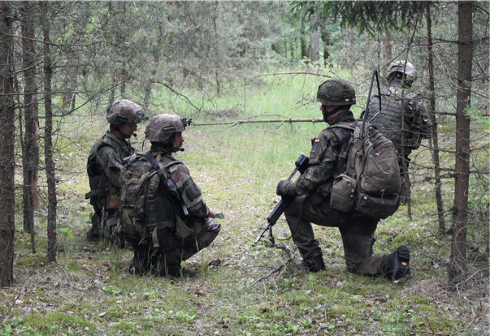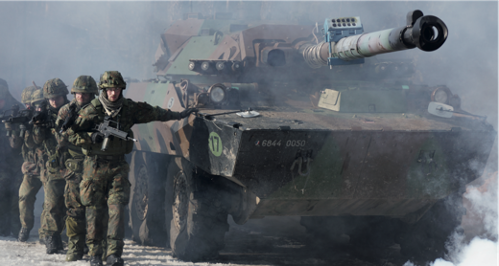The Franco-German Brigade
Basic Facts
The Franco-German Brigade, deployed on 2 October 1989, is a binational major military unit at brigade level. The idea of a close military cooperation has been formulated in the Elysée Treaty in 1963. In 1987, German chancellor Helmut Kohl and French president François Mitterand agreed to set up a combined Brigade during a summit in Karlsruhe. It is composed of six major military formations: the Jägerbataillon 291 and Jägerbataillon 292 (infantry battalions), the Artilleriebataillon 295 (artillery battalion), the German-French supply battalion, the 1. régiment d’infanterie (infantry regiment) and the 3e régiment de hussards (reconnaissance regiment). The Panzerpionierkompanie 550 (pioneer company) supports the mobility and blocking capacity of the brigade.
Due to the binational organization, the Brigade has military bases in Germany and France. The military bases are in Müllheim (Germany), Illkirch (France), Donaueschingen (Germany), Stetten am Kalten Markt (Germany), Sarrebourg (France) and Metz (France). The Jägerbataillon 291 in Illkirch is the only German combat battalion which is stationed abroad permanently. Weapon systems of the Brigade are for example the Panzerhaubitze 2000 or the MARS II (artillery), the AMX 10 RCR (reconnaissance/fire support vehicle) or the GTK Boxer (armored personnel carrier). The Fennek (reconnaissance vehicle) contributes to the reconnaissance capability of the Brigade. Soldiers of both nations get to know the partners material, particularly the personal equipment like the assault rifles Heckler & Koch G36 or Famas.

Main Tasks and Goals
In 2010, the main tasks and goals of the Brigade have been specified in the French/German agreement on the Franco-German Brigade. The agreement states, that the German-French Brigade contributes to the development of shared procedures, to enhance the interoperability between both nations. Besides, the Brigade shall develop shared principles for training, exercise and mission. The creation of a shared understanding shall be reached through the harmonization of the service.
Apart from the intended harmonization goals, the German or French battalions can be deployed in the framework of national defense strategy. In 2018, the Brigade has contributed troops to the international missions in Mali. French parts of the Brigade were deployed in the frame of “Operation Barkhane”, whereas the German soldiers participated in EU and UN missions to train Malian soldiers. The Brigade is also a sign of German-French cooperation and friendship, its external image shouldn’t be underestimated. In December 2020, it was also the largest single contributor to the mutual assistance under pandemic circumstances in southern Germany.
Current Role
The Franco-German Brigade serves as a fully operational brigade under the command of the German and French government. Each government is able to use its own contributed parts for its own purpose, with the support of the other side if necessary or possible. As mentioned, the Brigade and its components participate in out-of-area missions. In 2018, the Jägerbataillon 292 constituted the core of the NATO-Battlegroup Lithuania as part of the NATO mission Enhanced Forward Presence (EFP). Germany serves as framework nation in Lithuania. There are also three other NATO-Battlegroups in Latvia, Estonia and Poland. In this context, the German-French Brigade contributes to two key purposes: NATO, EU and national out-of-area missions as well as national and alliance defense.

The Brigade serves under the command of the European Corps, if it participates in exercises or missions under the command of the Corps or if it works on specific tasks in the framework of NATO or EU. Within the national framework, the German 10. Panzerdivision (10 Armoured Division) and the French 1re Division (First Division of the French Army) share the lead of the Brigade.
Vision
The treaty on the Franco-German Brigade states, that the Brigade has an outstanding relevance for the German-French cooperation. It should also strengthen the European defense. The Brigade can serve as a blueprint for the problems and synergies which can occur in the German-French cooperation, respectively an European defense cooperation between several EU-members. Most notably, the Brigade also serves as a symbol for the overcoming of past hostilities and the German-French national friendship.
Conclusion
Summarized, the German-French Brigade is an established part in the overall picture of French-German cooperation. The cooperation works, the success certainly has a positive influence on other projects like the C-130J Super Hercules combined squadron in Évreux. The fact, that the deployment of the Brigade has to be approved by both states, underlines the trust of both parties towards each other. It is a flagship project which works fine on the military level. This experience can help the German, French and other European governments to extend the scale of cooperation and to establish other bilateral or multilateral formations.

0 Comments